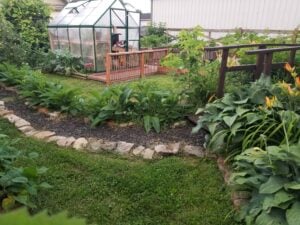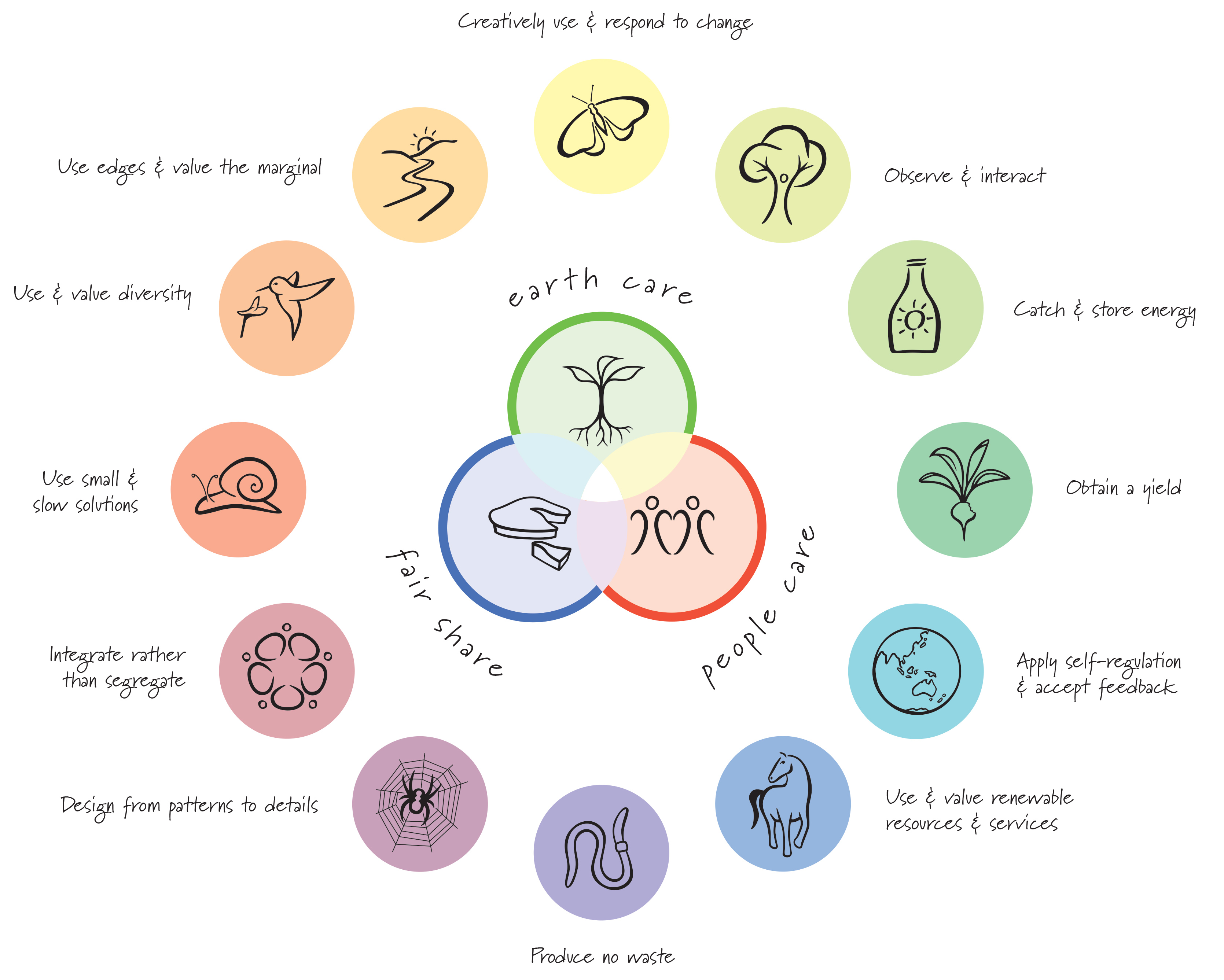
A few years ago when I started homesteading I had no idea what permaculture was, I was simply growing a few vegetables in some raised beds, planting a couple of fruit trees, and raising a few rabbits. Then permaculture came into my life and it changed everything about the way I was homesteading.
Everything I did had more purpose than ever before. Every plant I put in the ground was put there for a reason and usually multiple reasons. Every piece of infrastructure, every animal, literally everything was now working together in a symbiotic relationship.
How does homesteading in a permaculture way accomplish this? The answer is contained within the very definition of permaculture. Let’s look at the definition and break it down phrase by phrase and apply it to a functioning homestead.
What Is Permaculture?
A definition seems like an appropriate and simple place to start, but maybe not so simple. Permaculture has been defined in many ways depending on the application of permaculture to the situation. The simple definition is this – The term permaculture combines the words permanent and culture, or permanent and agriculture and as defined by Bill Mollison (the father of Permaculture) is a design system in which “the aim is to create systems that are ecologically-sound and economically viable, which provide for their own needs, do not exploit or pollute and are therefore sustainable in the long term. Permaculture uses the inherent qualities of plants and animals combined with the natural characteristics of landscapes and structures to produce a life-supporting system for city and country, using the smallest practical area.” -Bill Mollison, Introduction To Permaculture

“a design system”
Permaculture is a system of agricultural and social design principles centered around simulating or directly utilizing the patterns and features observed in natural ecosystems.
The purposeful design and maintaining of an agriculturally productive system that can have the diversity, stability, and resilience of natural ecosystems.
The layout or design of a homestead can be one of the most important things you can do. It will have a major impact on the production, efficiency, and the capabilities of your homestead.
Your homestead will be built on a design system. The question will be how good of a system will it be. A poor design system can reduce production and increase labor, a better way is a permaculture design.

“in which “the aim is to create systems that are ecologically-sound”
In layman’s terms, we might say it’s about creating systems that cause no harm to or perhaps even benefit the environment.
Considering the design of most modern-day farms or “food growing systems” this is extremely important if you care at all about the world that we live in. Today’s system designs care very little for the life in the soil, the water, the air, the plants, or the animals. They are designed solely for ease and production without any care for the sustainability of the environment surrounding them. This makes homesteading the permaculture way so much better in so many ways.

“economically viable”
A system with this viability means that the returns are more than the cost of capital.
A permaculture designed system isn’t satisfied just being better for the world it also has to be an economically sound system. This is one of the things that make it a sustainable system. If a system requires more capital to maintain than it can provide then the input will eventually run out and the system will die.

“which provide for their own needs”
A system or systems that supply everything it needs to thrive and accomplish all the goals of a system.
Sometimes this doesn’t happen in the early stages of a design but it is the eventual goal.
There was a time when I had to bring in soil amendments, compost, mulch, water, and other things my system required but as the system has matured it has been providing these things for itself.

“do not exploit or pollute”
This falls in line with being ecologically sound but is more specific to the requirements of a system.
A permaculture system does not take more than it can provide and does not cause harm to the planet in any way.
Modern farming practices are horrible in this way. They take from the soil until the soil has to be artificially amended in order to provide. Pesticides and herbicides pollute the soil, water, and air in a way that can never be corrected as long as it will continue to be done.

“sustainable in the long term”
A system that will continue to thrive for years, decades, or perhaps centuries without requiring more than it can provide for itself.
It is what every homesteader aims for, sustainability. A homestead that will provide for their needs for as long as they need it to.

“uses the inherent qualities of plants and animals”
Systems that imitate nature where plants benefit other plants, plants benefit animals, and animals benefit plants by what they provide. God created all things to work in a symbiotic way with one another but when we interrupt or modify the system in some way it destroys the natural design.
The great news is we have the intellect to put things back in balance and benefit in an abundant way from the land. Permaculture as a design science gives us the tools we need to provide for our own and nature’s needs in this relational way.

“combined with the natural characteristics of landscapes and structures to produce a life-supporting system”
This is where system designs that imitate nature and the architectural design of a homestead come together as earthworks and buildings work to serve together with natural characteristics to carry out the purpose of the design.

“for city and country”
These systems will work anywhere! There are many examples of permaculture being done successfully on large scale homesteads and small urban homesteads.
My homestead is an urban homestead consisting of 1/10 of an acre total with a house and garage taking up much of that space. Permaculture has enabled me to be able to grow several fruit trees, hundreds of pounds of vegetables, gallons of berries, hundreds of pounds of meat and eggs and do it all in a mostly closed-loop system.

“using the smallest practical area”
These systems are designed to be extremely efficient using only what space is needed to accomplish a goal allowing for more design to be implemented within a space to accomplish even more.

Conclusion
Permaculture Is A More Holistic Approach To Homesteading
This system takes into consideration all aspects of design and makes the most of every space. My conclusion is that although permaculture is not the only way to homestead successfully, in my opinion, it is a better way to homestead.
Resources:
Permaculture Books
-
Introduction to Permaculture – Bill Mollison https://amzn.to/2N5ohCH
-
Permaculture Designers Manual – Bill Mollison https://amzn.to/2N3AAPC
-
Principles and Pathways Beyond Sustainability – David Holmgren https://amzn.to/2yL2blL
-
Gaia’s Garden – Toby Hemenway https://amzn.to/2tISrmk
-
Rainwater Harvesting for Drylands and Beyond – Brad Lancaster (both volumes) https://amzn.to/2Kp6Drv and https://amzn.to/2N4IZSV
-
Teaming with Microbes – Jeff Lowenfels and Wayne Lew https://amzn.to/2tB4bI9
-
One Straw Revolution – Masanobu Fukuoka https://amzn.to/2KiO0da
-
Tree Crops a Permanent Agriculture – J. Russel Smith https://amzn.to/2N4KzUR
-
Edible Forest Gardens – Dave Jacke https://amzn.to/2Mskv4Z
-
The Earth Care Manual – Patrick Whitefield https://amzn.to/2tITN0o
-
Sepp Holzer’s Permaculture – Sepp Holzer https://amzn.to/2yQPPsk
-
The Permaculture Handbook – Peter Bane https://amzn.to/2N4aZ9t
Permaculture Ethics and Design Principles




